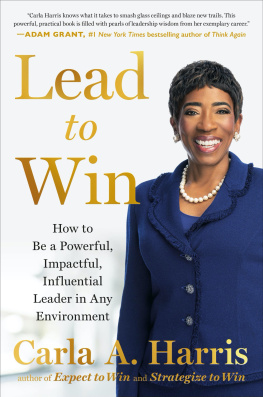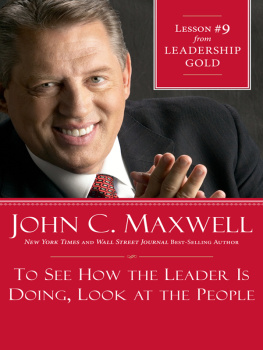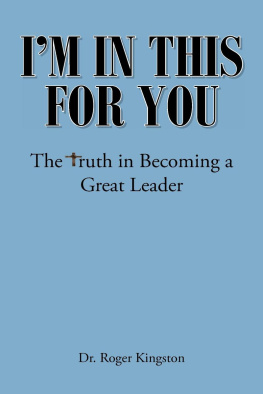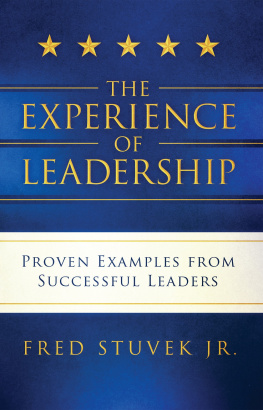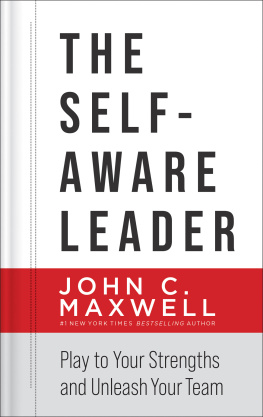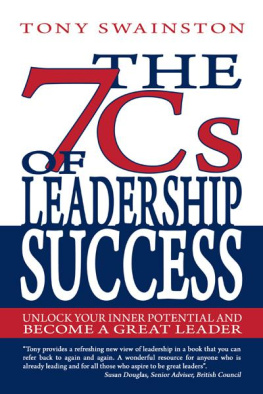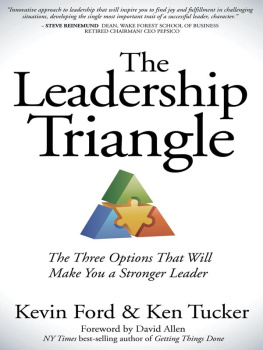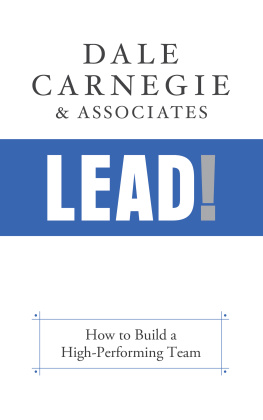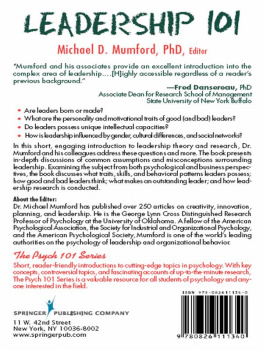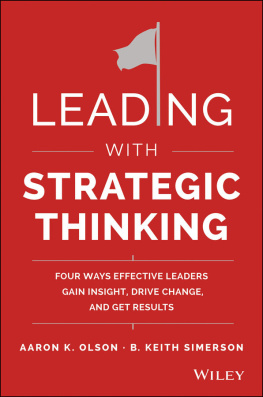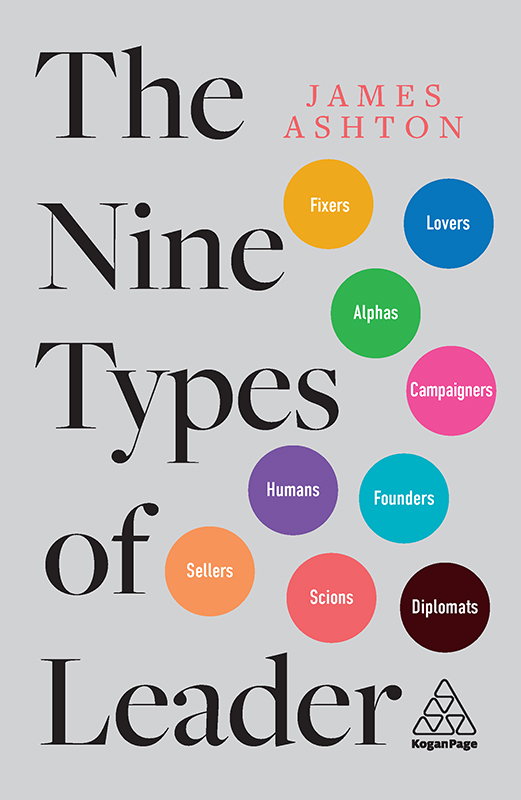
Contents
Landmarks
Page List
Praise for The Nine Types of Leader
This is a very well researched and uniquely observed encyclopaedia of leaders and leadership. A must-read for all current and aspiring leaders.
DAME CILLA SNOWBALL, WELLCOME TRUST GOVERNOR, GREAT PRIVATE SECTOR COUNCIL CHAIR AND FORMER GROUP CEO AND GROUP CHAIRMAN OF AMV BBDO
Every successful business is the result of successful leadership. However, there are wildly different types of leaders, with different strategies. Different markets, organizational cultures and industries require different leadership. And your own abilities and style determine your own leadership. James Ashton has produced a fresh, thoughtful, modern look at business leadership that will provide key insight to leaderships everywhere.
REID HOFFMAN, LINKEDIN CO-FOUNDER, AUTHOR OF BLITZSCALING AND HOST OF MASTERS OF SCALE PODCAST
Ive always said life is 50 per cent luck and 50 per cent what you do with it. James Ashtons The Nine Types of Leader captures the luck and actions of CEOs around the world, and then turns it into an opportunity for you to look at what youve been given and use it to shape the leader you will become.
AJAY BANGA, MASTERCARD EXECUTIVE CHAIRMAN
From interviews with a whos who of global business glitterati, James Ashtons new breakdown of nine types of leader is purposeful, authentic and delivered with his trademark readability.
STEVIE SPRING, CHAIRMAN OF THE BRITISH COUNCIL AND THE MENTAL HEALTH CHARITY MIND
James Ashton has managed to produce a book about leadership that stands out in a busy field and cuts through management waffle. Pin-sharp analysis of the different types of leader, insightful commentary about the many leadership personalities he has interviewed over the years and vivid storytelling. As you read, you cant help but think about the type of leader you are yourself (and secretly hope its the Human one). A great read thoroughly enjoyed it.
RITA CLIFTON, CBE, PORTFOLIO CHAIR, NON-EXECUTIVE DIRECTOR AND AUTHOR OF LOVE YOUR IMPOSTER
Business leaders are peculiar and brave. Few aspire to it; even fewer succeed. James Ashton has shrewdly tabulated his own butterfly collection of this exotic breed. Long on narrative, short on jargon and very entertaining.
SIR PETER BAZALGETTE, ITV CHAIRMAN AND FORMER CHAIR OF ARTS COUNCIL ENGLAND
James Ashton has a knack for unpicking how leaders motivations and methods develop over many years. This book neatly compiles a range of different approaches and suggests where leadership goes next as modern corporations and stakeholder demands evolve.
GAVIN PATTERSON, SALESFORCE PRESIDENT AND CHIEF REVENUE OFFICER AND FORMER CHIEF EXECUTIVE OF BT GROUP
The world needs more great leaders, and James Ashtons thoughtful taxonomy points the way towards better leadership. Career-minded executives should pick it up.
DAMBISA MOYO, GLOBAL ECONOMIST, AUTHOR, 3M AND CHEVRON BOARD DIRECTOR AND FORMER BOARD DIRECTOR OF BARRICK GOLD AND BARCLAYS
Packed full of fascinating real-world examples of the leaders that James Ashton has spent years researching and interviewing, this entertaining book shows how the different personality traits of leadership can play out in the human beings running some of our biggest businesses.
CHRIS HIRST, HAVAS CREATIVE GLOBAL NETWORK CHIEF EXECUTIVE AND AUTHOR OF NO BULLSH*T LEADERSHIP
A very readable book about the types of modern business leadership, sprinkled with great personal anecdotes and inside stories. If you only buy one book on leadership this year, make it this one!
BRIAN MCBRIDE, TRAINLINE CHAIRMAN, STANDARD LIFE ABERDEEN, WIGGLE AND KINNEVIK NON-EXECUTIVE DIRECTOR, FORMER CHAIRMAN OF ASOS AND FORMER CHIEF EXECUTIVE OF AMAZON.CO.UK
A timely book definitely one for the Davos crowd.
SARAH SANDS, FORMER BBC RADIO 4 TODAY PROGRAMME EDITOR AND FORMER EVENING STANDARD EDITOR
To Viveka and Alice, my greatest supporters, and to Oscar, who is always with us.
Contents
When I set out to write this book, I was determined not to produce another academic study of leadership. Much ink has been spilt on plenty of those, written by greater minds than mine. And besides, rather than combing through balance sheets or charts or board papers or decades of management theory to come up with something new and inspiring, my primary source material is largely all my own work.
Over more than 20 years of journalism I have accrued hours and hours in the company of chief executives. Sometimes fleetingly, for the best part of an hour across a boardroom table, in a recording studio or on a conference stage; sometimes socially too, getting to know them gradually over a long period at parties, breakfasts and dinners that oil corporate life in London and beyond. I hope it adds up to a detailed understanding of what makes the boss class tick, their ambitions and fears, how they got where they are and how they stay there.
In journalism, the power lies in opinion. It is why the populist Fox News thrived in the United States even before the Trump era and the divisive topic of Brexit left the BBC somewhat tongue-tied in its pursuit of editorial balance. Newspapers are viewspapers in which columnists hold sway, purveying thought-provoking, sometimes pungent views from beneath statesmanlike picture bylines. I like writing those too but must admit I have always loved conducting interviews, where the subject must obviously be the star and granted sufficient oxygen to speak.
Very early on in my career I remember journeying up to glamour-free Luton to the north of London to interview Sir Stelios Haji-Ioannou, his workspace a tiny perch at the end of a table in an aircraft hangar from where he masterminded the European expansion of the budget airline easyJet and was now turning his attention to other ventures. Another formative encounter was with Howard Schultz, the Starbucks tycoon, soon after he acquired the Seattle Coffee Company that gave the chain a bridgehead into the UK. Schultz appeared captive that day in a large armchair at the back of one of his coffee outlets as a production line of journalists processed past. It got me thinking about the nature of business, what drives the leaders behind these brands, and why they wanted to tell me about it.
Sports journalists have their star strikers and Olympic athletes, political writers obsess over the activities of ministers, senators, heads of state and the ideas of policy wonks. For me it has always been a fascination with chief executives, those leaders of giant workforces often larger than a stadium full of fans or a countrys population that generate great wealth, steward famous brand names or vital causes.
I soon understood my role. If I didnt ask the question I wanted answering then nobody would. At the age of 18, in a late-night interview conducted for my local hospital radio station in West Yorkshire, I still regret not having the bravado to ask the comedian Sir Ken Dodd about his tax affairs when I had the chance. More bite was needed and more preparation. Several years later, I resolved never to show up as unready as a journalist with whom I shared a slot for a joint interview itself a disastrous format. His opening gambit to the chief executive across the table was: So, what do you do?, which is the sort of small talk entre you might expect the British royal family to trot out.
The joy of an interview comes in three stages. There is the before: pulling apart a beautifully botoxed CV, plump with superlatives and vaunting achievement that, together with a read-around and a ring-around, acts as a useful guide to where the real story lies. There is the after: crafting 1,300 or so words that sum up the subject, with some emphasis on finding a colourful three-paragraph drop intro to entice readers in. It is the meat in the sandwich I enjoy most: part conversation, part joust. The sights, the sounds, the figuring out: where am I, who is this person, why do they deserve to feature in my publication?
Next page

